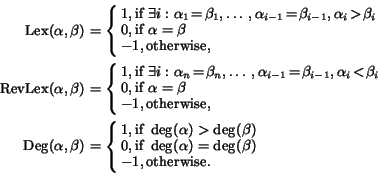the degree (resp. weighted degree) of a monomial
A monomial ordering > (term ordering) on the set of monomials
Mn is a total ordering on Mn which is compatible with the
natural semigroup structure, i.e.,
![]() implies
implies
![]() for any
for any
![]() .
A monomial ordering
is a well-ordering if
.
A monomial ordering
is a well-ordering if
![]() is the smallest
monomial. We furthermore call an ordering negative if
is the smallest
monomial. We furthermore call an ordering negative if
![]() is the largest monomial.
is the largest monomial.
Robbiano (cf.[15]) proved that any monomial ordering > can be
defined by a matrix
![]() :
:
![]() .
Matrix-based descriptions
of monomial orderings are very general, but have the disadvantage that
their realization in an actual implementation is usually rather
time-consuming. Therefore, they are not very widely used in
practice.
.
Matrix-based descriptions
of monomial orderings are very general, but have the disadvantage that
their realization in an actual implementation is usually rather
time-consuming. Therefore, they are not very widely used in
practice.
Instead, the most frequently used descriptions of orderings have at most two defining conditions: a (possibly weighted) degree and a (normal or reverse) lexicographical comparison. We call such orderings simple orderings. The most important simple orderings (and their SINGULAR abbreviations) are:
For monomials
![]() let
let


We furthermore call a monomial ordering > a degree based
monomial ordering if
![]() (e.g., Dp and
dp and their weighted relatives are degree based orderings).
(e.g., Dp and
dp and their weighted relatives are degree based orderings).
Due to the nature of the GB algorithm, monomial operations are by far the most frequently used primitive operations. For example, monomial comparisons are performed much more often than, and monomial additions at least as often as, arithmetic operations over the coefficient field. The number of divisibility tests depends very much on the given input ideal, but is usually very large, as well (see also Table 1).
Nevertheless, whether or not monomial operations dominate the running
time of a GB computation depends on the coefficient field of the
underlying polynomial ring: monomial operations are certainly
run-time dominating for finite fields with a small![]() characteristic (e.g., integers modulo a small prime
number), since an arithmetic operation over these fields can usually
be realized much faster than a monomial operation. However, for fields
of characteristic 0 (like the rational numbers), GB computations are
usually dominated by the arithmetic operations over these fields,
since the time needed for these operations is proportional to the size
of the coefficients which tend to grow rapidly during a GB
computation.
characteristic (e.g., integers modulo a small prime
number), since an arithmetic operation over these fields can usually
be realized much faster than a monomial operation. However, for fields
of characteristic 0 (like the rational numbers), GB computations are
usually dominated by the arithmetic operations over these fields,
since the time needed for these operations is proportional to the size
of the coefficients which tend to grow rapidly during a GB
computation.
Therefore, improvements in the efficiency of monomial operations will have less of an impact on GB computations over fields of characteristic 0.